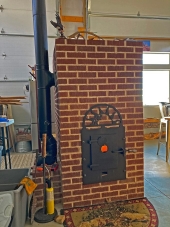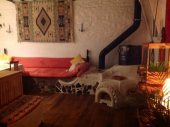
 8
8




 9
9









 3
3








 2
2




 1
1




Joe








Eric Bee wrote:... IOW, it takes a hardwood a lot longer to grow and it stores more carbon. ...




 3
3








 1
1








 2
2








 1
1




andy careaga wrote:Just a curiosity of mine (and I think you have probably been asked this many times already), but, why do you have the outside of the mass sided with wood?
I keep wondering if there is anything I can do to prevent so much heat loss from going out the stove pipe








paul wheaton wrote:It can make a huge difference.
We will be using pine, fir and larch. They have much lower BTU per cord than, say, osage organge or hickory. We are planting locust, oak and mulberry - but it will be a long time until we can use that.








Brian McCune wrote: what you think of coppiced wood growing systems for fuel?
Daniel Ray wrote:Along the lines of coppicing fuel. Anybody have any thoughts on coppiced mountain alder.





Along the lines of coppicing fuel. Anybody have any thoughts on coppiced mountain alder. I burned it in my RMH the other day and it seemed to burn well and it grows fast!
Hans Albert Quistorff, LMT projects on permies Hans Massage Qberry Farm magnet therapy gmail hquistorff




 1
1




 2
2








what you think of coppiced wood growing systems for fuel?
 2
2




Daniel Ray wrote:Great pebble stove by the way Paul, keep pushing the efficiency on people and maybe one day they will get it.
 1
1




Creighton Samuiels wrote:a better metric for judging the heat energy of firewood is by seasoned weight.
because my post EPA woodstove




andy careaga wrote:Here's another question I have been pondering. When I first built this RMH, the research I did led me to think that a 7"x7" firebox/tunnel would be a good idea since I had 8" dia stove pipe from the previous wood stove. I have been wondering lately if I would have been better off building a 6"x6" firebox, that maybe it would provide a better long term burn using a smaller amount of wood. Anyone have any thoughts on this? Maybe other benefits to using a smaller firebox I am unaware of?
 1
1




paul wheaton wrote:
Creighton Samuiels wrote:a better metric for judging the heat energy of firewood is by seasoned weight.
Perhaps what you meant to say is "I think a better metric for judging the heat energy of firewood is by seasoned weight."
I have a different position. Since I am doing the work, I am choosing to follow the universal standard format for measuring firewood: the cord.
because my post EPA woodstove
I think your post is not so much about this experiment as you would like to discuss the stove you have - which would be best in a different thread.




"Rules without reason create rebellion"




 5
5




Steve Boyd wrote:Paul, you say at the beginning of this thread that you are "... getting kinda sick of proving shit". I, for one, don't think you will prove anything by measuring the volume of wood you are burning. Measuring and comparing the weight of wood burnt would be only the only reasonable comparison given what we all know about the amount of energy contained in a given weight of wood/as opposed to volume. Saying that as you are the one who is "doing the work, I am choosing to follow the universal standard format for measuring firewood: the cord" contributes nothing to the discussion, or your own credibility. The cord is indeed a universal measurement of wood for when it is sold, but not as a measure of its calorific value - this is usually reflected in the price that is paid per cord.
 5
5




Steve Boyd wrote: contributes nothing to the discussion, or your own credibility.
 2
2




andy careaga wrote:Paul, so what are the characteristics of the house you are heating? How many rooms, square footage, construction type?
I am confident there is quite a bit of energy lost out the chimney from the air flowing through it.




M Johnson wrote:
Steve Boyd wrote:Paul, you say at the beginning of this thread that you are "... getting kinda sick of proving shit". I, for one, don't think you will prove anything by measuring the volume of wood you are burning. Measuring and comparing the weight of wood burnt would be only the only reasonable comparison given what we all know about the amount of energy contained in a given weight of wood/as opposed to volume. Saying that as you are the one who is "doing the work, I am choosing to follow the universal standard format for measuring firewood: the cord" contributes nothing to the discussion, or your own credibility. The cord is indeed a universal measurement of wood for when it is sold, but not as a measure of its calorific value - this is usually reflected in the price that is paid per cord.
I disagree. "How many cords of wood do you bur?" is a very common question when people talk stoves. Yes we can get into technical discussions if we want but the common person relates more to the cord. In my opinion of course.
Keep up the good work Paul
 1
1




paul wheaton wrote:
I have a different position. Since I am doing the work, I am choosing to follow the universal standard format for measuring firewood: the cord.
 3
3




Casie Becker wrote:... more than fair that you measured the efficiency of your stove by how much wood you had to cut for it. Especially for the homesteaders who grow and cut their own wood
 1
1




Steve Boyd wrote:Paul, you say at the beginning of this thread that you are "... getting kinda sick of proving shit". I, for one, don't think you will prove anything by measuring the volume of wood you are burning. Measuring and comparing the weight of wood burnt would be only the only reasonable comparison given what we all know about the amount of energy contained in a given weight of wood/as opposed to volume. Saying that as you are the one who is "doing the work, I am choosing to follow the universal standard format for measuring firewood: the cord" contributes nothing to the discussion, or your own credibility. The cord is indeed a universal measurement of wood for when it is sold, but not as a measure of its calorific value - this is usually reflected in the price that is paid per cord.


|
We must storm this mad man's lab and destroy his villanous bomb! Are you with me tiny ad?
Play Your Way to a Sustainable Lifestyle: Uncover Permaculture Principles with Each Card
https://gardener-gift.com/
|









